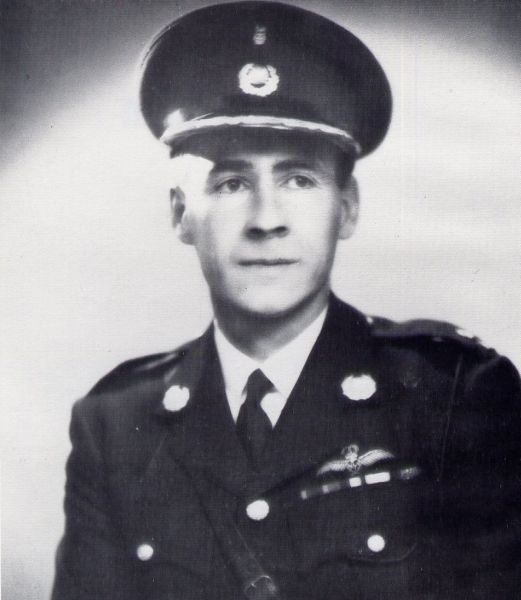Partridge, Richard Thomas
- Nationality:
- British
Biography
Richard Partridge enrolled in the Royal Navy on January 1st, 1929. After having received a posting aboard H.M.S. Hermes on the China Station, he opted for a career in aviation. He received his wings in July 1934. After a brief spell in the Royal Marines in November 1938, he returned to the Fleet Air Arm on May 17th, 1939.
April 27, 1940, Partridge shot down a Heinkel He 111 but he was forced to make an emergency landing in his Blackburn Skua on a frozen lake. Once on the ground, he and his gunner/observer R.S. Bostock made contact with the German crew of the Heinkel they had just shot down, Josef Auchtor, Feldwebel Karl-Heinz Strunck and Leutnant Horst Schopis. A fourth crewmember of the Heinkel had been killed during the crashlanding. Soon after they were caught by a Norwegian patrol. This story, in a romantised form, formed the basis for the Norwegian movie "Into the White" of 2012. The wreck of the Heinkel can still be found on the Norwegian hills, the wreck of the Blackburn Skua was recovered from the lake in 1974 and is now on public display in the FAA Museum in Yeovilton.
Partridge and his observer managed to rejoin their squadron and leave Norway in the nick of time. June 14th, 1940, Partridge and his unit took off to attack German naval vessels during which he was shot down. He managed to save himself with his parachute and was picked up, seriously injured, by a Norwegian fishing vessel. Partridge was interned as a PoW until the end of the war.
After his liberation he wanted to resume flying right away and he was appointed flying commander, R.N.A.S. Lee-on-Solent. He also took various courses and became the first Navy pilot to qualify for jet aircraft.
Later on, Partridge joined the Department of Air Organisation and Training. When he had to return to the Royal Marines he decided that the work offered to him made insufficient use of his flying experience and he retired at his own request on January 26th, 1951 in the rank of Major, Royal Marines.
Promotions:
January 1st, 1929: probational 2nd Lieutenant (Royal Marines);
?: Lieutenant;
September 17th, 1933: Flying Officer (Royal Air Force);
?: Captain (Royal Marines);
December 31st, 1937: Flight Lieutenant (from January 1st, 1938 onwards);
May 24th, 1939: Flight Lieutenant (from May 17th, 1939 onwards, seniority from January 1st, 1938).
Career:
Januari 1st, 1929: Royal Marines;
September 17th, 1933 - September 6th, 1934: RAF Leuchars;
September 7th, 1934 - December 31st, 1934: No. 802 Squadron, H.M.S. Courageous;
January 1st, 1935: No. 802 Squadron;
July 23rd, 1935 - June 30th, 1936: No. 802 Squadron, H.M.S. Glorious;
July 1st, 1936 - November 9th, 1937: No. 802 Squadron, H.M.S. Hermes;
November 10th, 1937 - October 15th, 1938: No. 802 Squadron, H.M.S. Glorious;
November 1938 - May 17th, 1939: Royal Marines;
June 1st, 1939 - June 30th, 1939: FAA Fighter School, Eastleigh;
November 30th, 1939 - December 26th, 1939: Commanding Officer No. 804 Squadron, Hatston;
March 29th, 1940: Commanding Officer No. 800 Squadron, Hatston;
April 24th, 1940 - June 13th, 1940: Commanding Officer No. 800 Squadron, H.M.S. Ark Royal;
November 10th, 1945: Commanding Officer R.N.A.S. Lee-on-Solent;
1946: Empire Flying School.
Do you have more information about this person? Inform us!
- Period:
- Second World War (1939-1945)
- Rank:
- Captain
- Unit:
- Commanding Officer, No. 800 Squadron, Fleet Air Arm, Royal Navy
- Awarded on:
- May 9th, 1940
"Received for daring and resource in the conduct of hazardous and successful operations by the Fleet Air Arm against the enemy, especially on the coast of Norway."
LG 34845/2785.
- Period:
- Second World War (1939-1945)
- Rank:
- Captain
- Unit:
- Commanding Officer, No. 800 Squadron, Fleet Air Arm, Royal Navy
- Awarded on:
- June 25th, 1940
"Received for daring and resource in the conduct of hazardous and successful operations by the Fleet Air Arm on the Coast of Norway."
LG 34882/3919.
- Period:
- Second World War (1939-1945)
- Rank:
- Captain
- Unit:
- Commanding Officer, No. 800 Squadron, Fleet Air Arm, Royal Navy
- Awarded on:
- July 19th, 1940
"Received for daring, resource and continued devotion to duty in
operations by the Fleet Air Arm against, the enemy over the Coast of Norway."
LG 34901/4491.
- Period:
- Second World War (1939-1945)
- Awarded on:
- March 29th, 1946
- Period:
- Second World War (1939-1945)
- Period:
- Second World War (1939-1945)
Sources
- Photo 1: Royal Navy photo
- - The London Gazette of 4th January 1929, Issue 33454
- The London Gazette of 26th September 1933, Issue 33981
- The London Gazette of 31st December 1937, Issue 34468
- The London Gazette of 9th June 1939, Issue 34634
- Supplement to The London Gazette of 7th May 1940, Issue 34845, dated 9th May 1940
- Supplement to The London Gazette of 25th June 1940, Issue 34882, dated 25th June 1940
- Supplement to The London Gazette of 19th July 1940, Issue 34901, dated 19th July 1940
- Flying Marines







